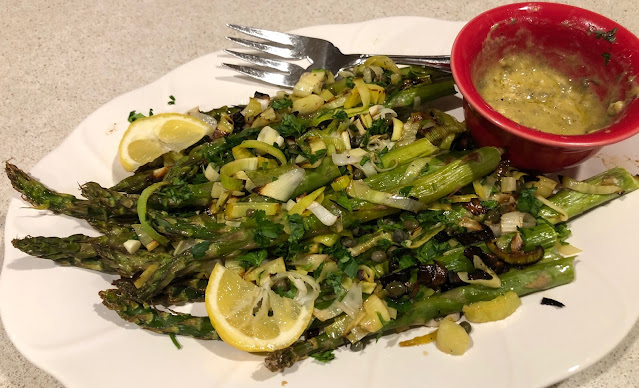
Recipe: Celebrate the new season with an easy vegetable side

|
I'm so happy to see asparagus show up. It means spring is arriving and all the other great vegetables of the season will soon follow.
Grilled asparagus is my favorite, but roasted is right behind. And with propane still hard to find (thanks, Covid-19), I'd just as soon use my oven as much as possible now to cook and hope I can fire up the grill for real later.

|
This roasting recipe, adapted from one by the New York Times' Melissa Clark, specifically calls for fatter asparagus stalks, which I prefer anyway. I grew up in Stockton, which once was the center of asparagus farming in California. Something about that Delta soil, I think.
The sauce here is optional but it is excellent. Just saying. And don't skip the fresh lemon juice -- it cuts through the richness of the Dijon mustard beautifully.
Roasted asparagus with crispy leeks and capers
Serves 3-4 as a first course or side
Ingredients:
1 pound thick asparagus stalks (1/2-inch diameter or larger), ends trimmed
2 tablespoons extra-virgin olive oil, divided
Salt and freshly ground black pepper

|
2 tablespoons drained capers
1 lemon, halved, then cut into 8 wedges (some will be used in the sauce)
1/4 cup chopped fresh parsley
For sauce:
2 teaspoons Dijon mustard
2 teaspoons drained capers, finely chopped
1 garlic clove, minced
2 tablespoons extra virgin olive oil
Salt and freshly ground pepper
Instructions:
Heat oven to 425 degrees. Place trimmed asparagus on a rimmed baking sheet and toss with 1 tablespoon olive oil and 1/2 teaspoon salt.
Put the leek slices in a bowl and stir in the other 1 tablespoon olive oil and a pinch of salt and a few grinds of pepper. Scatter the leeks over the asparagus on the pan, then scatter the capers over that.
Roast the asparagus 12-18 minutes, until the asparagus is tender and showing some golden brown.
Make the sauce while the asparagus is roasting. Stir together the mustard, capers and garlic in a bowl, then slowly stir in, 1 at a time, the 2 tablespoons of olive oil until it forms a thickish emulsion. Squeeze the juice from two of the lemon wedges into the sauce, and stir until combined. Taste and adjust seasoning with salt and pepper.

I got a little carried away when cutting up the lemon.
Slicing each half into fourths is sufficient. Two
wedges of juice are used in the sauce. |
Serve with the mustard sauce and the remaining lemon wedges on the side.
I highly recommend serving small white beans with this if it is part of a full meal -- the beans play especially well with the leeks and the mustard.
Comments
0 comments have been posted.Sacramento Digs Gardening to your inbox.
Sites We Like
Garden Checklist for week of May 12
Get your gardening chores and irrigation done early in the day before temperatures rise.
* Plant, plant, plant! It’s prime planting season in the Sacramento area. Time to set out those tomato transplants along with peppers and eggplants. Pinch off any flowers on new transplants to make them concentrate on establishing roots instead of setting premature fruit.
* Direct-seed melons, cucumbers, summer squash, corn, radishes, pumpkins and annual herbs such as basil.
* Harvest cabbage, lettuce, peas and green onions. This heat will cause leafy greens and onions to flower; pick them before they bolt.
* In the flower garden, direct-seed sunflowers, cosmos, salvia, zinnias, marigolds, celosia and asters.
* Plant dahlia tubers. Other perennials to set out include verbena, coreopsis, coneflower and astilbe.
* Transplant petunias, marigolds and perennial flowers such as astilbe, columbine, coneflowers, coreopsis, dahlias, rudbeckia and verbena.
* Keep an eye out for slugs, snails, earwigs and aphids that want to dine on tender new growth.
* Feed summer bloomers with a balanced fertilizer.
* For continued bloom, cut off spent flowers on roses as well as other flowering plants.
* Got fruit trees? If you haven't already done so, thin orchard fruit such as apples, peaches, pears, pluots and plums before they grow too heavy, breaking branches or even splitting the tree. Leave the largest fruit on the branch, culling the smaller ones, and allow for 5 to 6 inches (or a hand's worth) between each fruit.
* Thin grape bunches, again leaving about 6 inches between them. For the remaining bunches, prune off the "tail" end, about the bottom third of the bunch, so that the plant's energy is concentrated in the fruit closest to the branch.
* As spring-flowering shrubs finish blooming, give them a little pruning to shape them, removing old and dead wood. Lightly trim azaleas, fuchsias and marguerites for bushier plants.
* Add mulch to the garden to help keep that precious water from evaporating. Mulch also cuts down on weeds. But don’t let it mound around the stems or trunks of trees or shrubs. Leave about a 6-inch to 1-foot circle to avoid crown rot or other problems.